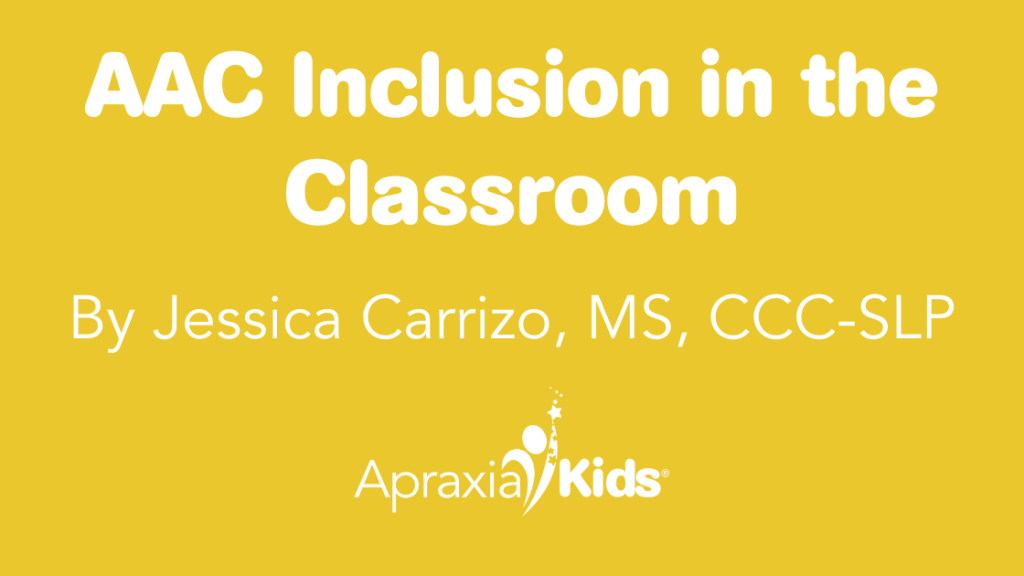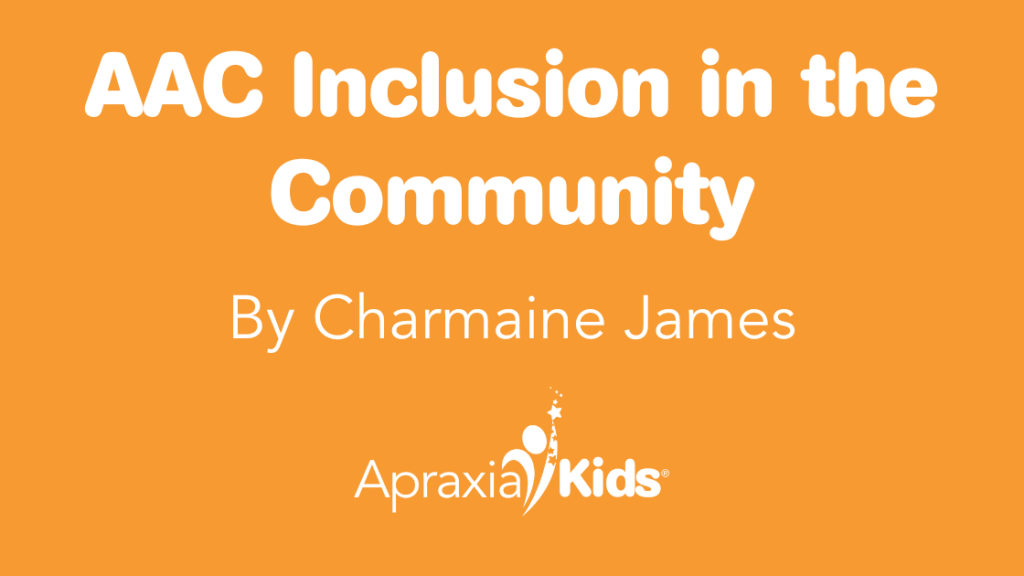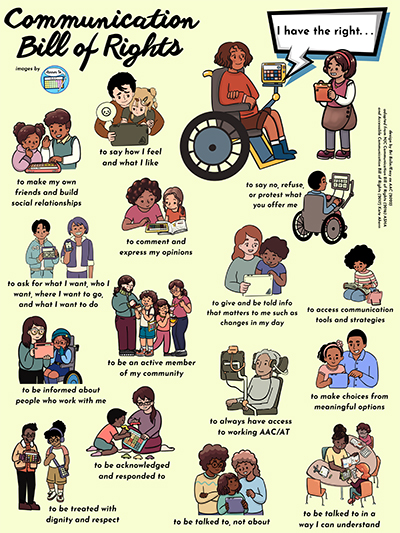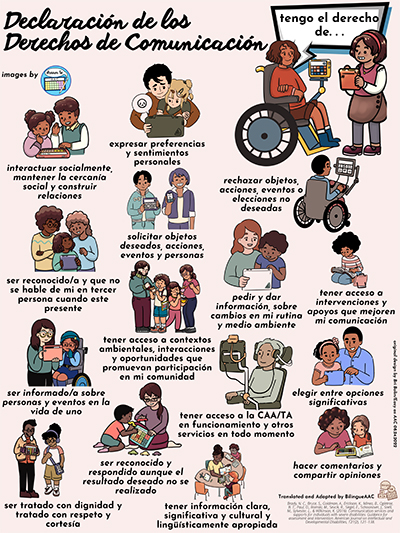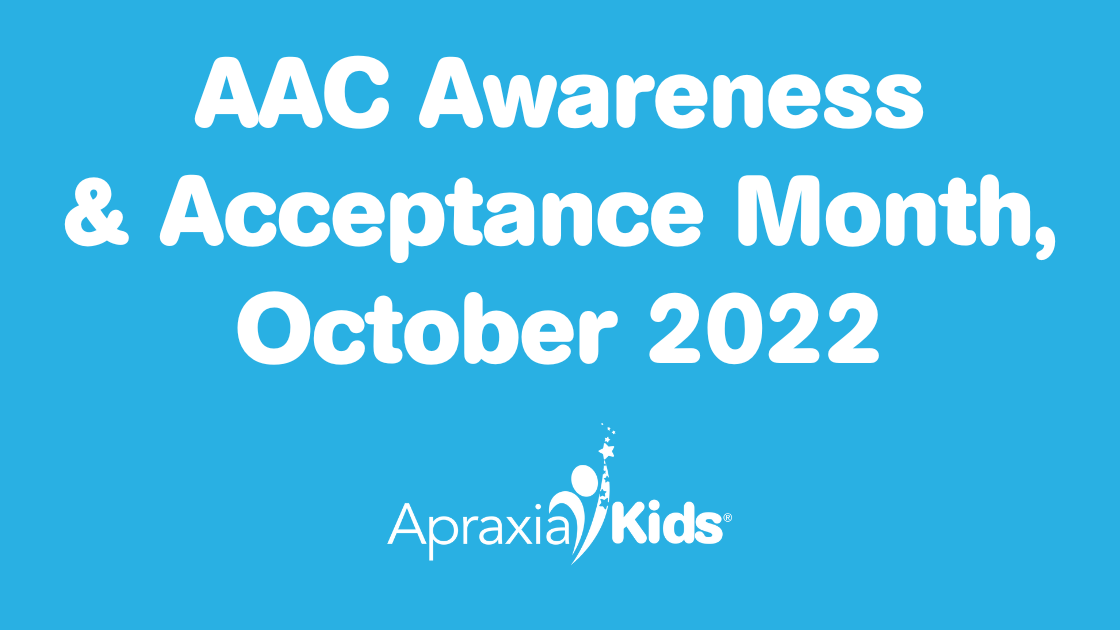
02 Oct AAC Awareness & Acceptance Month
October is AAC Awareness & Acceptance Month. AAC, or Augmentative Alternative Communication, is an incredibly valuable tool that helps break down communication barriers so that all voices can be heard. We have compiled a variety of AAC resources to help you, your apraxia star, and all AAC users to communicate to your highest potential!
Apraxia Kids is also excited to announce that our
Speech Tablets for Apraxia Program applications are now open!
Applications Open October 3, 2022
Applications must be submitted/postmarked by December 12, 2022
Decision Notifications in January 2023
An Introduction to AAC
What Is AAC?
- AAC stands for Augmentative Alternative Communication.
- “Augmentative” comes first because we always want to “augment” what someone already uses to communicate, whether it be speech, gestures, or body language.
- “Alternative” for those who have some speech, but their speech is difficult to understand or isn’t enough to meet their needs.
- “Low Tech” AAC options are simple types of communication systems that include communication picture boards, Picture Exchange Communication System (PECS), and use of signs/gestures.
- “High Tech” AAC includes speech generating devices made specifically for communication and communication apps installed on phones, tablets, or iPads that produce speech as buttons are activated.
How will AAC help my child?
- AAC provides additional support for verbal speech so your child can use multiple modalities to communicate, such as hand gestures or more formal signs, along with verbal output and maybe symbol pictures. We all use a variety of ways to communicate, including writing notes, texting, etc. in addition to speaking. Your child deserves the right to have access to all the tools available to communicate.
- AAC is visual and concrete – providing more than verbal words to assist with recalling words to express. AAC symbols don’t disappear once they are touched like verbal words do when we speak them. AAC communication symbols remain as a reference or reminder as to what was verbally said. They also provide a cue to the child for what they are thinking and might want to say.
- AAC reduces the pressure of using only spoken words, which often is a source of frustration for children who struggle to communicate.
- AAC can help your child be understood, increasing the likelihood that a listener can “catch” the meaning of the unintelligible utterance by providing a visual referent.
- AAC can also be a practice tool by providing an imitation cue or model for the child to practice speech or verbal output independently.
Will AAC cause my child to not want to talk?
- AAC will stop my child from talking or reduce their motivation to improve speech.
- While multiple research studies have been conducted since this was initially proposed back in the 1980’s, no one has been able to provide any evidence to support the decrease in speech production or willingness of a child to talk when using AAC. Children, as well as adults, will gravitate to the fastest and easiest means of communicating. AAC is not a faster communication system. It is, however, a multi-dimensional system that provides an additional way to communicate if speech is hard. Much like you and I will use our phone to take a picture of information rather than write it down or type it into our phone, we look and learn to use the quickest route. If a child can talk, they will. They are not talking because they are not motivated or acting out.
- AAC helps bridge the gap and helps reduce frustration.
Where do I start?
- The first step is to get an AAC Evaluation from a Speech-Language Pathologist, with specialized training in AAC. The SLP should evaluate what your child understands (receptive language ability) and what is currently communicated (verbal and nonverbal communication methods) as well as symbol knowledge, visual discrimination abilities, and fine and gross motor abilities. If your child has other diagnoses besides CAS, then other disciplines as well as other areas might be evaluated. The SLP should look at low and high tech AAC options and should demonstrate a variety of systems. The SLP should have a background in AAC, preferably with ties to ASHA and USSAAC. They might also have an ATP Certification from RESNA.
- Talk with your child’s SLP about using a picture board or other type of low tech AAC to trial the effectiveness of AAC before spending money to purchase a system.
- Trialing a variety of high tech AAC systems (Communication Apps, speech generating devices and tablets) leads to a match between your child’s communication and language abilities and needs and product. You wouldn’t purchase a car without a test-drive, why do you trust your child’s communication to a social media post? Check out your state AT Program (every state has one!) Some have lending programs to allow you to try before purchasing through private funding or insurance.
- Check out vendor websites for more detailed information about apps/software or AAC. Many companies have very detailed information about their program features. Each language system has particular features that stand out – you should be able to compare products and determine which one is the most appropriate to you and your child BEFORE you purchase. Seek professional help. You are not expected to know this! Vendors include (but are not limited to) PRC-Saltillo, Tobii Dynavox, Forbes AAC, Assistiveware, and Avaz.
- You can also browse our free App Guide with your SLP to see if any of those apps would be a good match.
How can I help my child use their AAC device?
- My child has an AAC system but they just doesn’t use it. What can I do?
- AAC is a tool to improve communication. If your AAC User doesn’t understand how to use the tool then it is not useful and will be abandoned.
- Look at what is going on in the environment. Do you use it with your child or is the burden of use on the child? How often do you model use of the AAC system? How are you modeling use? Is the AAC system (low or high tech) used with only a focus on getting something? Communication is more than asking for a cookie.
- Lead by example. Inspire. Help your child and demonstrate your support by using the AAC system yourself in front of your child and showing them how to use this tool. There are plenty of programs outlining how to be a better communication partner to your AAC User (SMORRES, MASTER PAL, Project CORE, ImPAACT Program).
Article written by Anne Kuhlmeier from our Apraxia Kids Parent Portal
Guest Blogs on AAC
By Jessica Carrizo, MS, CCC-SLP, Member of the Diversity & Inclusion Task Force for Apraxia Kids
Jessica is a bicultural SLP who is passionate about apraxia, bilingualism and biculturalism, AAC, and inclusion. Read more from Jessica about how classrooms can support AAC users so that all students can be successful together.
By Charmaine James, Member of the Diversity & Inclusion Task Force for Apraxia Kids
Charmaine is an apraxia mom who worked hard to get a communication board in her local playground so all children could communicate. Then another communication board was installed, and another, and another! Now Charmaine has her own nonprofit that works to place communication boards around the community. Read more
Download and Share this “Communication Bill of Rights”
Communication is a basic right, regardless of what that communication looks like! This Communication Bill of Rights is a great way to remind others that everyone deserves a voice. Share with your community to make communication and AAC inclusive for all!
Design by Bri Bolin/Easy as AAC (2022). Adapted from NJC Communication Bill of Rights (2016) ASHA and Accessible Communication Bill of Rights (2017) Kate Ahern. Images by Drawn to AAC. Translated and Adapted by BilingueAAC.
English – Communication Bill of Rights
Children’s Books Featuring AAC Users
Beyond Words
by Dana Hall
Emily Meets Rocky
by Nichol Norman
How Katie Got a Voice (and a cool new nickname)
by Patricia Mervine, MA, CCC-SLP
Something to Say About My Communication Device
by Eden Molineux
I Talk in Different Ways
by Amanda C. Hartmann
AAC Rhyme Time
by Amanda C. Hartmann
Me and My AAC
by Tabitha Cabrera
Do You Like the Way I Talk?
by Tabitha Cabrera
My Monster Truck Goes Everywhere with Me (Illustrated in American Sign Language)
by Kathleen Marcath, Issac Liang, and Pardeep Mehra
DON’T MISS OUT ON THESE GREAT APP SALES!
Original List created by Lauren Gonzales, MA, CCC-SLP
October 10-16, 2022
50% off LAMP Words for Life®, TouchChat®,
and Dialogue® AAC by PRC-Santillo
October 1-31, 2022
50% off WordToob: Language Learning Video Modeling App
October 11-17, 2022
50% off Choiceworks, Choiceworks Calendar,
and the Choiceworks Bundle
October 1-16, 2022
10% off entire order at PicSeePal
Use code AAC22 at https://picseepal.com/ for AAC protective gear
October 11-17, 2022
50% off AssistiveWare apps including Proloquo2Go, Proloquo4Text, Pictello, Keeble, and On-Demand AAC Training Videos AND New Customers receive 1 extra free trial month on select apps
October 1-31, 2022
50% off Spoken AAC
October 1-15, 2022
50% off Talk Suite Pro 1st week of October
33% off Talk Suite Pro 2nd week of October
October 19-28, 2022
50% off GoVisual Scene Maker by Attainment Company
October 1-31, 2022
50% off Alexicom AAC apps
October 1-15, 2022
50% off Speak for Yourself!
October 2-8, 2022
50% off lifetime account of CoughDrop
October 10-16, 2022
50% off Predictable and Scene & Heard by Therapy Box
October 1-15, 2022
50% off Avaz AAC and MDA Avaz Reader by Avaz Inc.
Learn More About AAC from Apraxia Kids
Join our Apps for Apraxia Kids Facebook Support Group to connect with other AAC users.
Browse our App Guide with your SLP to find the best apps for your apraxia star.
Read this article about Sign Language, Tablets, and Other Communication Forms.
Enjoy these webinars to learn how you can help your AAC user be successful:
Sign Language Resources
Sign Language is an important language for more than just our apraxia stars, but even incorporating just a few simple signs with your child can help them drastically as they find their voice. Using sign language with apraxia can reduce frustration, provide meaningful and expressive communication, encourage communication, provide visual cues, and more!
Watch this webinar to learn how to use Sign Language to Support Emergent Speech in Children with CAS.
Gallaudet University – Learn basic American Sign Language (ASL) online with free categorized videos
Signing Savvy – Information about sign language and an ASL Dictionary
Hand Speak – Search for specific words and phrases in ASL
Sign Language 101– 10 lessons for learning signs
Signing Time – Sign Language dictionary and other great resources
Picture Communication Boards
Using AAC doesn’t have to be an expensive system, high tech device, or anything extreme. You can make your own picture communication tools any time! You can search online and print out pictures, take pictures with camera and print, have your child help draw/color pictures and you can glue them on file folders. Then put these in a small photo book you can find at the dollar store, or on index cards, and put them on a ring to make them last longer and keep them organized. There are also lots of free downloads and resources online to help you start your own!
Do 2 Learn – Printable picture cards
Teachers Pay Teachers – Search for communication boards, graphics, and more
My PECS System – Communication board system
PrAACtical AAC – Tips, resources, and free downloads
Here are some things to consider when you are creating your own communication boards for your apraxia star:
- Pictures of foods/drinks they do like and don’t like. They can use this picture to talk about these foods/drinks, request to put them on the shopping list, add what they like to their pizza, or even order in a restaurant
- Pictures of their friends/teachers/activities/toys at school to talk about when they’re at home, if applicable
- Pictures of his family/extended family/pets to talk about (cousins, siblings…)
- Pictures of things they like to do or places they like to go – even if they can’t go there right now, they can express it
- Emotion pictures or emojis to let them tell you how they are feeling – mad, happy, bored, scared, hurt, sick, sleepy, hungry, etc.
- Pictures of descriptions – funny, silly, yucky, yummy, pretty, big, small, colors, etc.
- Pictures to use while playing games – my turn, your turn, wait, stop, yes, no
Additional AAC Resources
AAC Descriptions and Studies from ASHA (American Speech-Language-Hearing Association)
PrAACtical AAC – Tips, resources, and free downloads
School Health – Various AAC options for purchase
Cuespeak – Designed for adults, but may also be helpful for some young learners
Project Core – Provides learning opportunities on implementing AAC
AAC Language Lab – Provides free resources, tools, guides, and more.
BilingueAAC is set to provide bilingual AAC resources to families and professionals that work with bilingual AAC users. Our vision is to provide a platform that enables professionals and families to feel empowered to provide bilingual AAC services that are evidence-based and culturally affirming.
BilingueAAC es creado para proporcionar recursos de CAA bilingües a familias y profesionales que trabajan con personas bilingues que usan la CAA. Nuestra visión es proporcionar una plataforma que permite a los profesionales y las familias sentirse empoderados para brindar servicios bilingües de CAA basados en evidencia y que sean culturalmente afirmativos.
DISCLAIMER
Apraxia Kids does not endorse any one book, method, program, organization, service, or approach. Rather, we share information so families & professionals can make informed choices for children with CAS as they work to find their voices.
October is AAC Awareness & Acceptance Month. AAC, or Augmentative Alternative Communication, is an incredibly valuable tool that helps break down communication barriers so that all voices can be heard. We have compiled a variety of AAC resources to help you, your apraxia star, and all AAC users to communicate to your highest potential!
Apraxia Kids is also excited to announce that our
Speech Tablets for Apraxia Program applications are now open!
Applications Open October 3, 2022
Applications must be submitted/postmarked by December 12, 2022
Decision Notifications in January 2023
An Introduction to AAC
What Is AAC?
- AAC stands for Augmentative Alternative Communication.
- “Augmentative” comes first because we always want to “augment” what someone already uses to communicate, whether it be speech, gestures, or body language.
- “Alternative” for those who have some speech, but their speech is difficult to understand or isn’t enough to meet their needs.
- “Low Tech” AAC options are simple types of communication systems that include communication picture boards, Picture Exchange Communication System (PECS), and use of signs/gestures.
- “High Tech” AAC includes speech generating devices made specifically for communication and communication apps installed on phones, tablets, or iPads that produce speech as buttons are activated.
How will AAC help my child?
- AAC provides additional support for verbal speech so your child can use multiple modalities to communicate, such as hand gestures or more formal signs, along with verbal output and maybe symbol pictures. We all use a variety of ways to communicate, including writing notes, texting, etc. in addition to speaking. Your child deserves the right to have access to all the tools available to communicate.
- AAC is visual and concrete – providing more than verbal words to assist with recalling words to express. AAC symbols don’t disappear once they are touched like verbal words do when we speak them. AAC communication symbols remain as a reference or reminder as to what was verbally said. They also provide a cue to the child for what they are thinking and might want to say.
- AAC reduces the pressure of using only spoken words, which often is a source of frustration for children who struggle to communicate.
- AAC can help your child be understood, increasing the likelihood that a listener can “catch” the meaning of the unintelligible utterance by providing a visual referent.
- AAC can also be a practice tool by providing an imitation cue or model for the child to practice speech or verbal output independently.
Will AAC cause my child to not want to talk?
- AAC will stop my child from talking or reduce their motivation to improve speech.
- While multiple research studies have been conducted since this was initially proposed back in the 1980’s, no one has been able to provide any evidence to support the decrease in speech production or willingness of a child to talk when using AAC. Children, as well as adults, will gravitate to the fastest and easiest means of communicating. AAC is not a faster communication system. It is, however, a multi-dimensional system that provides an additional way to communicate if speech is hard. Much like you and I will use our phone to take a picture of information rather than write it down or type it into our phone, we look and learn to use the quickest route. If a child can talk, they will. They are not talking because they are not motivated or acting out.
- AAC helps bridge the gap and helps reduce frustration.
Where do I start?
- The first step is to get an AAC Evaluation from a Speech-Language Pathologist, with specialized training in AAC. The SLP should evaluate what your child understands (receptive language ability) and what is currently communicated (verbal and nonverbal communication methods) as well as symbol knowledge, visual discrimination abilities, and fine and gross motor abilities. If your child has other diagnoses besides CAS, then other disciplines as well as other areas might be evaluated. The SLP should look at low and high tech AAC options and should demonstrate a variety of systems. The SLP should have a background in AAC, preferably with ties to ASHA and USSAAC. They might also have an ATP Certification from RESNA.
- Talk with your child’s SLP about using a picture board or other type of low tech AAC to trial the effectiveness of AAC before spending money to purchase a system.
- Trialing a variety of high tech AAC systems (Communication Apps, speech generating devices and tablets) leads to a match between your child’s communication and language abilities and needs and product. You wouldn’t purchase a car without a test-drive, why do you trust your child’s communication to a social media post? Check out your state AT Program (every state has one!) Some have lending programs to allow you to try before purchasing through private funding or insurance.
- Check out vendor websites for more detailed information about apps/software or AAC. Many companies have very detailed information about their program features. Each language system has particular features that stand out – you should be able to compare products and determine which one is the most appropriate to you and your child BEFORE you purchase. Seek professional help. You are not expected to know this! Vendors include (but are not limited to) PRC-Saltillo, Tobii Dynavox, Forbes AAC, Assistiveware, and Avaz.
- You can also browse our free App Guide with your SLP to see if any of those apps would be a good match.
How can I help my child use their AAC device?
- My child has an AAC system but they just doesn’t use it. What can I do?
- AAC is a tool to improve communication. If your AAC User doesn’t understand how to use the tool then it is not useful and will be abandoned.
- Look at what is going on in the environment. Do you use it with your child or is the burden of use on the child? How often do you model use of the AAC system? How are you modeling use? Is the AAC system (low or high tech) used with only a focus on getting something? Communication is more than asking for a cookie.
- Lead by example. Inspire. Help your child and demonstrate your support by using the AAC system yourself in front of your child and showing them how to use this tool. There are plenty of programs outlining how to be a better communication partner to your AAC User (SMORRES, MASTER PAL, Project CORE, ImPAACT Program).
Article written by Anne Kuhlmeier from our Apraxia Kids Parent Portal
Guest Blogs on AAC
By Jessica Carrizo, MS, CCC-SLP, Member of the Diversity & Inclusion Task Force for Apraxia Kids
Jessica is a bicultural SLP who is passionate about apraxia, bilingualism and biculturalism, AAC, and inclusion. Read more from Jessica about how classrooms can support AAC users so that all students can be successful together.
By Charmaine James, Member of the Diversity & Inclusion Task Force for Apraxia Kids
Charmaine is an apraxia mom who worked hard to get a communication board in her local playground so all children could communicate. Then another communication board was installed, and another, and another! Now Charmaine has her own nonprofit that works to place communication boards around the community. Read more
Download and Share this “Communication Bill of Rights”
Communication is a basic right, regardless of what that communication looks like! This Communication Bill of Rights is a great way to remind others that everyone deserves a voice. Share with your community to make communication and AAC inclusive for all!
Design by Bri Bolin/Easy as AAC (2022). Adapted from NJC Communication Bill of Rights (2016) ASHA and Accessible Communication Bill of Rights (2017) Kate Ahern. Images by Drawn to AAC. Translated and Adapted by BilingueAAC.
English – Communication Bill of Rights
Children’s Books Featuring AAC Users
Beyond Words
by Dana Hall
Emily Meets Rocky
by Nichol Norman
How Katie Got a Voice (and a cool new nickname)
by Patricia Mervine, MA, CCC-SLP
Something to Say About My Communication Device
by Eden Molineux
I Talk in Different Ways
by Amanda C. Hartmann
AAC Rhyme Time
by Amanda C. Hartmann
Me and My AAC
by Tabitha Cabrera
Do You Like the Way I Talk?
by Tabitha Cabrera
My Monster Truck Goes Everywhere with Me (Illustrated in American Sign Language)
by Kathleen Marcath, Issac Liang, and Pardeep Mehra
DON’T MISS OUT ON THESE GREAT APP SALES!
Original List created by Lauren Gonzales, MA, CCC-SLP
October 10-16, 2022
50% off LAMP Words for Life®, TouchChat®,
and Dialogue® AAC by PRC-Santillo
October 1-31, 2022
50% off WordToob: Language Learning Video Modeling App
October 11-17, 2022
50% off Choiceworks, Choiceworks Calendar,
and the Choiceworks Bundle
October 1-16, 2022
10% off entire order at PicSeePal
Use code AAC22 at https://picseepal.com/ for AAC protective gear
October 11-17, 2022
50% off AssistiveWare apps including Proloquo2Go, Proloquo4Text, Pictello, Keeble, and On-Demand AAC Training Videos AND New Customers receive 1 extra free trial month on select apps
October 1-31, 2022
50% off Spoken AAC
October 1-15, 2022
50% off Talk Suite Pro 1st week of October
33% off Talk Suite Pro 2nd week of October
October 19-28, 2022
50% off GoVisual Scene Maker by Attainment Company
October 1-31, 2022
50% off Alexicom AAC apps
October 1-15, 2022
50% off Speak for Yourself!
October 2-8, 2022
50% off lifetime account of CoughDrop
October 10-16, 2022
50% off Predictable and Scene & Heard by Therapy Box
October 1-15, 2022
50% off Avaz AAC and MDA Avaz Reader by Avaz Inc.
Learn More About AAC from Apraxia Kids
Join our Apps for Apraxia Kids Facebook Support Group to connect with other AAC users.
Browse our App Guide with your SLP to find the best apps for your apraxia star.
Read this article about Sign Language, Tablets, and Other Communication Forms.
Enjoy these webinars to learn how you can help your AAC user be successful:
Sign Language Resources
Sign Language is an important language for more than just our apraxia stars, but even incorporating just a few simple signs with your child can help them drastically as they find their voice. Using sign language with apraxia can reduce frustration, provide meaningful and expressive communication, encourage communication, provide visual cues, and more!
Watch this webinar to learn how to use Sign Language to Support Emergent Speech in Children with CAS.
Gallaudet University – Learn basic American Sign Language (ASL) online with free categorized videos
Signing Savvy – Information about sign language and an ASL Dictionary
Hand Speak – Search for specific words and phrases in ASL
Sign Language 101– 10 lessons for learning signs
Signing Time – Sign Language dictionary and other great resources
Picture Communication Boards
Using AAC doesn’t have to be an expensive system, high tech device, or anything extreme. You can make your own picture communication tools any time! You can search online and print out pictures, take pictures with camera and print, have your child help draw/color pictures and you can glue them on file folders. Then put these in a small photo book you can find at the dollar store, or on index cards, and put them on a ring to make them last longer and keep them organized. There are also lots of free downloads and resources online to help you start your own!
Do 2 Learn – Printable picture cards
Teachers Pay Teachers – Search for communication boards, graphics, and more
My PECS System – Communication board system
PrAACtical AAC – Tips, resources, and free downloads
Here are some things to consider when you are creating your own communication boards for your apraxia star:
- Pictures of foods/drinks they do like and don’t like. They can use this picture to talk about these foods/drinks, request to put them on the shopping list, add what they like to their pizza, or even order in a restaurant
- Pictures of their friends/teachers/activities/toys at school to talk about when they’re at home, if applicable
- Pictures of his family/extended family/pets to talk about (cousins, siblings…)
- Pictures of things they like to do or places they like to go – even if they can’t go there right now, they can express it
- Emotion pictures or emojis to let them tell you how they are feeling – mad, happy, bored, scared, hurt, sick, sleepy, hungry, etc.
- Pictures of descriptions – funny, silly, yucky, yummy, pretty, big, small, colors, etc.
- Pictures to use while playing games – my turn, your turn, wait, stop, yes, no
Additional AAC Resources
AAC Descriptions and Studies from ASHA (American Speech-Language-Hearing Association)
PrAACtical AAC – Tips, resources, and free downloads
School Health – Various AAC options for purchase
Cuespeak – Designed for adults, but may also be helpful for some young learners
Project Core – Provides learning opportunities on implementing AAC
AAC Language Lab – Provides free resources, tools, guides, and more.
BilingueAAC is set to provide bilingual AAC resources to families and professionals that work with bilingual AAC users. Our vision is to provide a platform that enables professionals and families to feel empowered to provide bilingual AAC services that are evidence-based and culturally affirming.
BilingueAAC es creado para proporcionar recursos de CAA bilingües a familias y profesionales que trabajan con personas bilingues que usan la CAA. Nuestra visión es proporcionar una plataforma que permite a los profesionales y las familias sentirse empoderados para brindar servicios bilingües de CAA basados en evidencia y que sean culturalmente afirmativos.
DISCLAIMER
Apraxia Kids does not endorse any one book, method, program, organization, service, or approach. Rather, we share information so families & professionals can make informed choices for children with CAS as they work to find their voices.
Credentials:
Hours of Operation:
Treatment locations:
Address:
,
Phone:
Email:
Overall Treatment Approach:
Percent of CAS cases:
Parent Involvement:
Community Involvement:
Professional consultation/collaboration:
Min Age Treated:
Max Age Treated:
Insurance Accepted:




